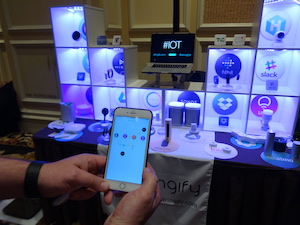
Simple solution for home automation chaos.
Stringify has mixed the glue that will bind home automation and the other gizmos and platforms of the Internet of Things together. Two weeks ago, the Los Gatos, California-based startup launched its server-based and mobile centric meta-platform that allows consumers to control 200 products and services offered by dozens of companies via a single smartphone app.
It’s a brilliantly simple proposition: instead of using a dozen different apps to control a dozen different products, a consumer installs one app that talks to a server that talks to a dozen different servers – cloud to cloud, if you like – and makes them all work together.
Organising a company TGIF was the example demoed at the Pepcom showcase at CES last night. Instead of starting the music, lowering the lights and alerting the crew that the keg has been tapped app by app everytime, you use an intuitive graphical interface on the Stringify app to, well, string it all together so you can trigger your standard party procedure whenever the pressure sensor on the kegerator says we’re go for lift-off.
That’s how it works in theory at least. The key is taking advantage of the APIs (application programming interfaces) published by service providers, including traditional home automation players like Google’s Nest as well as social media platforms like Twitter or web services like Dropbox. Home automation is just one of the many Internet and IoT market segments it addresses.
For now, it’s only available for iOS. Android will have to wait, said CEO Mike Yurochko, while they get it right on the iPhone. That’s both an economic necessity – Stringify is still working off of its $6.3 million seed funding round, led by ARTIS Ventures last April – and appropriate. I’ve taken a hack or two at home automation and struggled with an explosion of apps on my phone. Watching the Stringify demo invoked the same total conceptual shift as going from DOS to the Mac’s GUI did 30 years ago.
